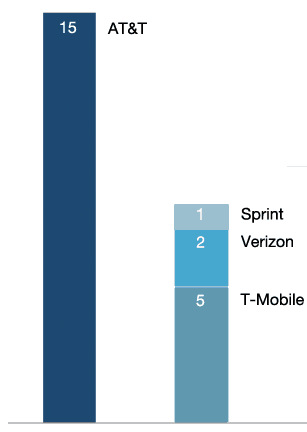A new joint investigation by Frontline and ProPublica reveals serious lapses in safety for America’s cell tower workers, a career now considered one of the most hazardous and life-threatening in America.
In the last eight years, 50 climbers have died, with many more injured installing and servicing cell sites for AT&T, Verizon Wireless, Sprint, and T-Mobile. The investigation finds many of these deaths and injuries were preventable, but as America’s profitable cell phone companies outsource jobs to cut-rate subcontractors (and the sub-contractors they often use themselves), safety measures take a back seat to low-ball bidding and profits.
Efforts to hold companies accountable are stymied by the byzantine layers of third party companies hired to do the work, an under-equipped federal safety agency, and difficulty assessing where the responsibility lies when things go wrong.
From ProPublica and Frontline:
From their perch atop the contracting chain, carriers typically set many of the crucial parameters for work on cell sites, including deadlines, pay rates and even technical specifications, down to the exact degree an antenna should be angled. An analysis of cell tower deaths by ProPublica and PBS “Frontline” showed that tight timetables and financial pressure often led workers to take fatal shortcuts or to work under unsafe conditions.
“We’ve had a number of situations where we think that accidents were caused by companies trying to meet deadlines and … cutting corners on safety in order to meet those deadlines,” said Jordan Barab, OSHA’s deputy administrator.
But Barab said it’s difficult for the agency to hold cell companies responsible for safety violations involving subcontractors. In most cases, federal officials have interpreted OSHA regulations to mean that carriers can be held accountable only if they exercised direct control over subcontractors’ work or were aware of specific unsafe conditions.
OSHA has not sanctioned cell carriers for safety violations implicated in any subcontractor deaths on cell sites since 2003, a review of agency records by ProPublica and PBS “Frontline” found.
OSHA has made little effort to systematically connect the deaths of tower workers to specific carriers and had not known until ProPublica and PBS “Frontline” told them that there have been 15 fatalities on AT&T jobs since 2003 – more than at the other three major carriers combined over the same period.
The agency attempted to fine a carrier just once and failed, losing a nearly three-year legal battle with a regional cell company in Kentucky. The agency has never taken on the four major carriers – Verizon, T-Mobile, AT&T and Sprint – even though there have been almost two dozen fatalities on jobs done for their networks.
Most of OSHA’s enforcement efforts have focused on a transient cast of small subcontractors, though they, too, typically have eluded significant penalties. Over the last nine years, the median fine levied for safety violations linked to a fatal tower accident was $3,750, an analysis by ProPublica and PBS “Frontline” showed.
[flv width=”512″ height=”308″]http://www.phillipdampier.com/video/PBS Frontline Cell Tower Deaths 5-23-12.flv[/flv]
Watch this segment from PBS Frontline exploring ‘Cell Tower Deaths,’ and what can be done to stop them. (30 minutes)


 Subscribe
Subscribe








